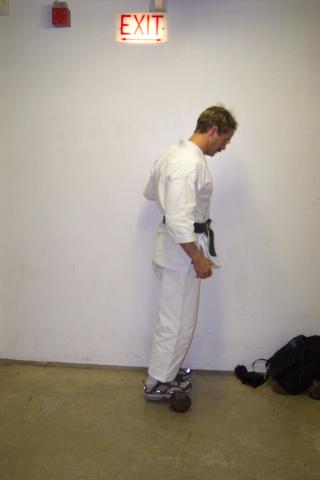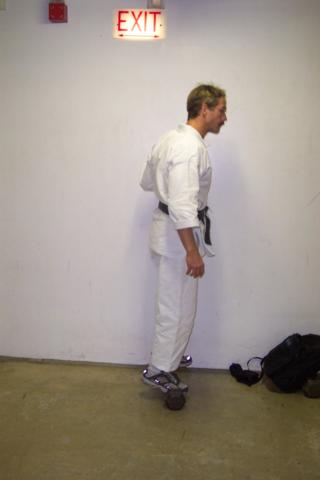Calf raises.
Description:
Motions trained: None, but calf strength is needed for most standing bodyweight exercises.
Main muscles used: Calves
Other muscles:
How to do it: I like to use a dumbbell or stair step. Stand on one foot,
lightly holding something for support. Only the ball of your foot should be touching, the
heel should be in space. Rise on the ball of the foot by pointing your toes. Lower and repeat.
How to work up to it: Do double calf-raises, i.e. with both
feet at once, starting out on level ground. Then try it standing on the
bell (or a stair step if you like).
Do it at the next level by holding a dumbbell. When that gets
easy, try single leg calf-raises.
Ramping it up: Do these plyometrically to build power. From the
top position, drop your weight and just as you reach the bottom, reverse direction.
You might want to do this with two legs the first couple of times to make sure
you kow your feet won't slip. If you get really active, watch drifting over
the edge of the step or off the dumbbell!
Do's and don'ts: Don't bend your knees. Flexing your knees is
not working your calves.
Comments: I really hate calf-raise machines. These are large, fancy
contraptions that put a weight on
your shoulders and have you do the motions described. The problem is, again,
mathematics. Doing a double-legged raise means you are moving half your
bodyweight. Piling your whole bodyweight onto one of these machines – which
brings you up to doing single-legged raises – usually means that you
have too high a load on your shoulders and back. I used to use one of those
until I realized that my trapezius muscles were sore from that. Then I switched
to single-legged raises and haven't looked back
Another thought is that most jumping or skipping movements rely on strong calf
muscles. They plyometric version of these gives you effectively a no-impact
way to train explosive calf strength.



